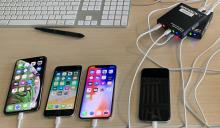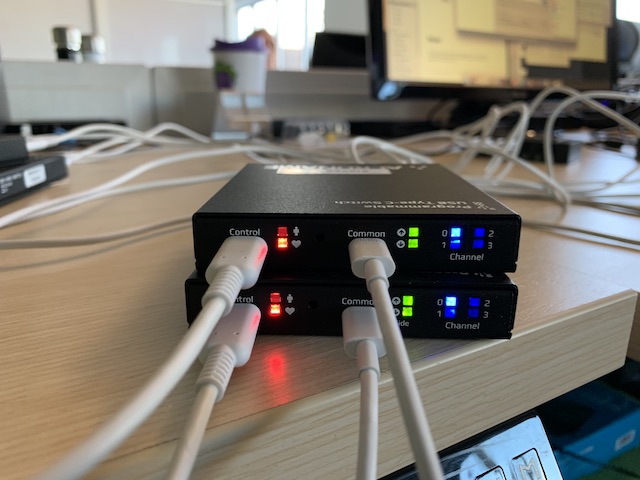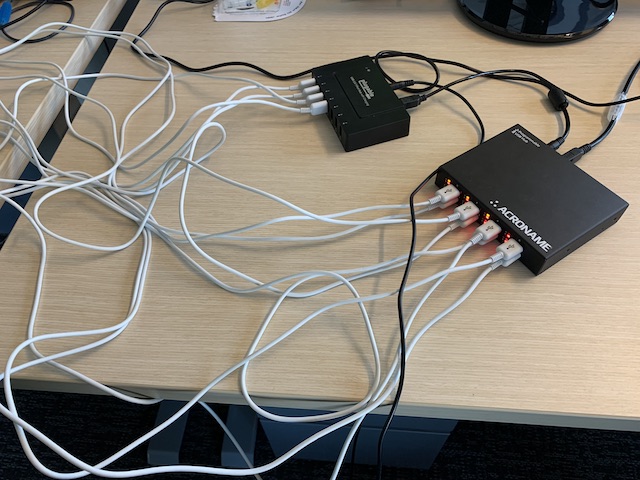
Eliminate Battery Swelling with Acroname USB Hubs and Switches
For device compatibility and mobile application development labs (commonly called “device farms” or “CI or continuous improvement labs”), battery swelling in mobile devices is a common, costly, and potentially dangerous problem. Not only are devices themselves expensive and labor-intensive to replace, but older or legacy devices are often difficult to source. Last but not least, swollen batteries can leak, cause fires, or even explode, damaging much more than the mobile device itself.
The root cause of battery swelling is unintelligent and continuous charging. This can be difficult to solve for in a mobile lab, as mobile devices require constant connection to a USB hub to allow wired communication. However, leaving devices connected to a typical USB hub means phones are constantly charging. Constant charging over long time periods creates overcharging conditions, leading to potentially dangerous battery swelling and failure.
With advanced control and monitoring features not available in typical USB hubs, Acroname’s industrial programmable USB hubs and switches are used throughout the mobile device testing industry to help reduce, if not eliminate, battery swelling. With techniques described below, Acroname hubs allow for intelligent control of charging to remove the conditions that cause swelling. Moreover, monitoring afforded by the Acroname hub’s current and voltage sensing capabilities can alert engineers to changes in charging profiles, helping to predict when battery failure is starting. Both intelligent charging and monitoring are easily accomplished through the included Acroname USB software, and can be easily incorporated into your automated test framework.
Reducing power
Utilizing software control, Acroname USB hubs can:
- periodically disconnect an individual device
- change the power profile negotiated between the hub and the device
- provide a minimal current to the device. This low level of current tricks the phone into keeping its data link active, but it is too low to allow the phone to charge its battery.
Using these methods individually or in combination can help stop devices from entering over-charge conditions.
Monitoring charge profiles
Measuring charging current to the device over time allows test engineers to create a known charging profile for each device. By monitoring charging current trends against the known profile, you can assess which devices have changed their charge profiles and may need to be replaced.
Recently, we spoke with Jon Flowers from Eggplant.io (acquired in June 2020 by Keysight), who implemented Acroname hubs and switches as part of a large scale mobile application testing lab. Jon was kind enough to provide us with some comments and photos:
Eggplant is an intelligent test automation company. Many of our clients have tests that run continuously against iOS devices using our iOS Gateway software. Continuous testing can lead to device battery bloat, because testing requires devices to be connected to a computer via USB cable (so the battery is constantly being charged, even if it’s full). Replacing devices is expensive, and it can be difficult or even impossible to replace devices that run older OS versions. Eggplant customers relied on us to find a solution, so we reached out to Acroname to see if their programmable USB hub might work.
We used one Acroname USBHub3+ and four USB-C-Switch devices to handle four iOS devices. We used two USB ports on the USBHub3+ for each USB-C-Switch. One port was set to have data and low power output, and the other was set to have data and high power output. Those USB ports were plugged into Port 0 and Port 1 of the USB-C-Switch. The common port on the Switch was connected to the iOS device. We used the same setup for each of the iOS devices.
Eggplant added logic to iOS Gateway to change the selected power port on the USB-C-Switch based on the charge level of the device. When the device reached 80% charge, the port was switched to the low power port. When the device dropped to 30% charge, the port was switched to the high power port. This allowed devices to stay charged for testing while not allowing the batteries to drain completely or be overcharged.


Thank you, Jon, for the writeup, as well as for using our hubs!
Learn more about Acroname's industrial programmable USB hubs and switches in our web store. Each product (including our innovative USB-C cables, which allow users of our four port USB-C switch to do amazing things) has a detailed page filled with specifications and downloadable reference materials. If may we answer any questions about our USB hubs and switches and their fitness for your application, please reach out to us!
Add New Comment